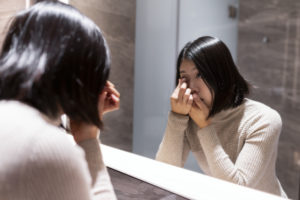May 2, 2022
By Dwight Akerman, OD, MBA, FAAO, FBCLA, FIACLE
 Traditionally, eye care professionals have been reluctant to fit children younger than age 12 with contact lenses because of concerns regarding adverse events, non-compliance, and lack of motivation. However, with the incidence of myopia at record levels, children are being fitted at younger ages with single-use soft contact lenses for myopia control.
Traditionally, eye care professionals have been reluctant to fit children younger than age 12 with contact lenses because of concerns regarding adverse events, non-compliance, and lack of motivation. However, with the incidence of myopia at record levels, children are being fitted at younger ages with single-use soft contact lenses for myopia control.
This paper reports the frequency and type of ocular and non-ocular adverse events related to soft contact lens wear in children.
Children aged 7 to 11 wore soft contact lenses for three years. Adverse events were defined by a slit lamp examination finding of grade 3 or worse; parental report of a clinically meaningful change (determined by the examiner) in eyes, vision, or health; or a clinically significant response (determined by the examiner) to a symptom checklist. Adverse events were categorized and reported by examiners and finalized by the executive committee.
The 294 participants wore their contact lenses 73.0 ± 26.5 hours per week, and 220 (74.8%) encountered at least one adverse event. Of the 432 adverse events, 75.2% were ocular, and 24.8% were non-ocular. Contact lens wear was probably or definitely related to 60.6% of the ocular and 2.8% of the non-ocular adverse events. None of the ocular adverse events were serious, severe, or caused permanent contact lens discontinuation. The corneal infiltrate incidence was 185 cases/10,000 patient-years of wear (95% CI: 110—294). The incidence of moderate ocular adverse events that were definitely or probably related to contact lens wear was 405 cases/10,000 patient-years of wear (95% CI: 286—557).
Of the 107 non-ocular adverse events, six were serious: two cases were for psychiatric observation, two for injuries, one for possible meningitis, and one for fibromyalgia. Of the non-ocular adverse events, 97 were unrelated to contact lens wear, two were possibly related (headache and visual symptoms with unknown cause), one was probably related (headache), and seven were unknown.
The researchers concluded that the adverse events experienced by 7 to 11-year-old myopic children rarely required meaningful treatment and never led to permanent discontinuation of contact lens wear or loss of best-corrected vision. Contact lenses provide a safe option for children who do not want to wear spectacles or want to try daily wear contact lenses as a method to slow the progression of myopia.
Abstract
Ocular and Non-Ocular Adverse Events during Three Years of Soft Contact Lens Wear in Children
Amber Gaume Giannoni, Matt Robich, David A Berntsen, Lisa A Jones-Jordan, Donald O Mutti, Jill Myers, Kimberly Shaw, Maria K Walker, Jeffrey J Walline, BLINK Study Group
Significance: Children are being fitted at younger ages with soft contact lenses for myopia control. This three-year investigation of adverse events related to contact lens wear in 7 to 11-year-old participants helps optometrists understand what to expect when fitting children with soft contact lenses.
Purpose: The purpose of this paper is to report the frequency and type of ocular and non-ocular adverse events related to soft contact lens wear in children.
Methods: Seven to 11-year-old children wore soft contact lenses for three years. Adverse events were defined by a slit lamp examination finding of grade 3 or worse; parental report of a clinically meaningful change (determined by the examiner) in eyes, vision, or health; or a clinically meaningful response (determined by the examiner) to a symptom checklist. Adverse events were categorized and reported by examiners and finalized by the executive committee. The presence or absence of an infiltrate and a list of diagnoses were determined at the conclusion of the study.
Results: The 294 participants wore their contact lenses 73.0 ± 26.5 hours per week, and 220 (74.8%) encountered at least one adverse event. Of the 432 adverse events, 75.2% were ocular, and 24.8% were non-ocular. Contact lens wear was probably or definitely related to 60.6% of the ocular and 2.8% of the non-ocular adverse events. None of the ocular adverse events were serious, severe, or caused permanent contact lens discontinuation. The corneal infiltrate incidence was 185 cases/10,000 patient-years of wear (95% CI: 110-294). The incidence of moderate ocular adverse events that were definitely or probably related to contact lens wear was 405 cases/10,000 patient-years of wear (95% CI: 286-557).
Conclusions: The adverse events experienced by 7 to 11-year-old myopic children rarely required meaningful treatment and never led to permanent discontinuation of contact lens wear or loss of best-corrected vision.
Giannoni, A. G., Robich, M., Berntsen, D. A., Jones-Jordan, L. A., Mutti, D. O., Myers, J., … & BLINK Study Group. Ocular and Non-ocular Adverse Events during Three Years of Soft Contact Lens Wear in Children. Optometry and Vision Science, 10-1097.
DOI: 10.1097/OPX.0000000000001902













